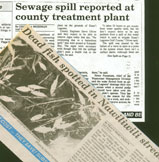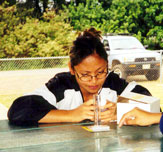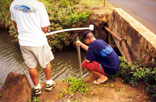|
|
|
|
|
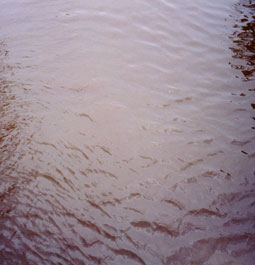 |
|
'Ainakumuwai is the land that is the source of the water. It
is another name for the watershed. The quality of a stream's
water depends on its source. Rain runs off of the land into
streams, or percolates into the groundwater. What ever the rain
carries into a stream affects the qualities of that stream. |
|
|
|
|
|
|
|
|
'Ainakumuwai draws on
the Division of Aquatic Resources Web site: Hawaiian Stream
Animals - the Mauka to Makai Connection. In addition, Don
Heacock's Hawaiian Stream Ecosystems: 140 years of change,
present conditions, and the future of stream conservation and
restoration is a major source. |
|
|
| High quality Hawaiian
streams are clear, cold, and have a strong flow all year long.
There is little sediment, leaf litter, and other loose debris
because of uninterrupted stream flow and flash floods caused
by heavy rains in the mountains. Flow rates can rise and fall
rapidly in response to rainfall. Hawaiian streams have a relatively
short and steep descent from the mountains, and their bottoms
are typically basalt (bedrock, boulders, cobbles, gravel, and
sand). Any withdrawal of water by well, tunnel or diversion
affects the streamflow .(Mauka to Makai Connection) |
|
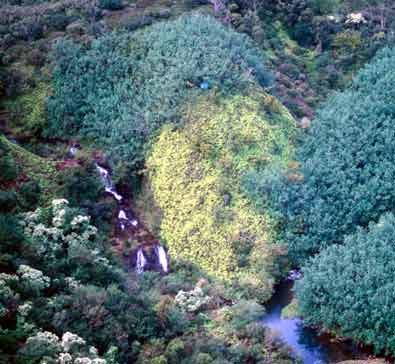 |
|
|
Above, Hali'i waterfall.. Notice
the tent in the hau bush. Photo by David Boynton, pilot
- Casey Riemer of Jack Harter Helicopters. |
|
|
|
|
|
|
|
|
|
|
|
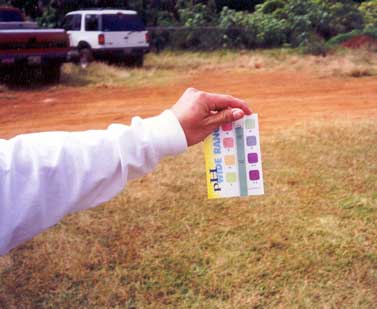 |
|
When you go to the doctor, he may
order a blood test to check for the proper balance of materials
that indicates good health. In the same way, a healthy stream
has a correct balance of physical, chemical, and biological
parts. The water quality in our streams reflects the health
of aquatic resources and the human communities that depend on
streams for food and recreation. The degradation (loss of quality)
of streams at Nawiliwili Bay indicates that our land and water
use are not sustainable. Streams are a good indicator of the
health of our land. (Heacock) |
|
|
|
|
|
|
|
|
|
|
The designation of Nawiliwili
Bay as a Water Quality Limited Segment is a result of the degradation
of the streams that drain into Nawiliwili Bay. One major reason
for this degradation is the high pollution run-off from non-
point sources. This is called Non Point Source Pollution (NPSP).
Pollutants include: sediment from agriculture and development
- oil, grease and toxic chemicals from vehicles - fertilizers,
herbicides, and pesticides from agriculture - and viruses and
bacteria from failing septic systems. When rain falls, the run-off
carries all this NPSP into our streams. |
|

|
|
|
|
|
|
|
|
|
|
|
|
|
Headlines from John Schlegel
|
|
|
|
|
|
|
|
|
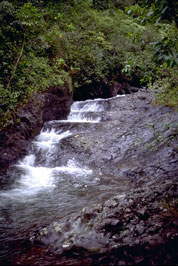 |
|
To the left is a high quality stream in upper Wainiha. Notice
the:
- clarity of the water,
- strong stream flow,
- basalt substrate (bottom)
- natural riparian (along the stream bank) vegetation
- native stream animals still thrive (grow vigorously) in
this pristine (untouched) environment.
|
|
|
Photo by Mike Kido
|
|
|
|
|
|
|
|
|
To the right, another example from Wainiha of a high quality
Hawaiian stream, courtesy of Mike Kido.
That's his sampling gear on the rock. |
|
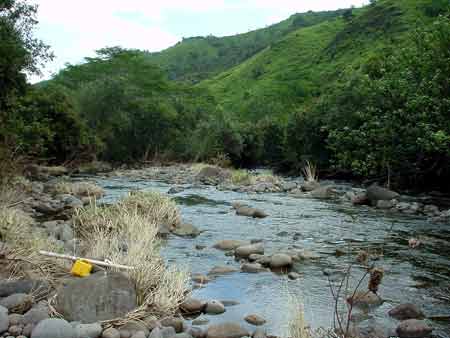 |
|
|
|
|
|
|
|
|
Nawiliwili Stream:
What's wrong with this picture?
Students call the fish that swim here "ghetto tilapia". |
|
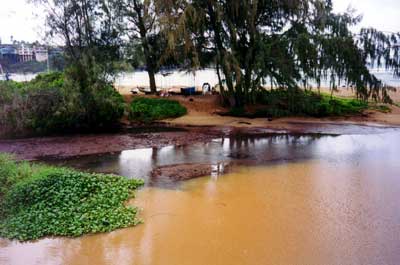 |
|
|
|
|
|
|
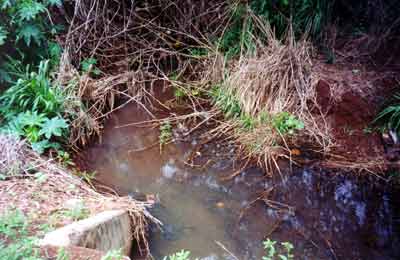 |
|
Papalinahoa Stream:
What's wrong with this picture?
|
|
|
|
|
|
|
Pu'ali Stream:
What's wrong with this picture? |
|
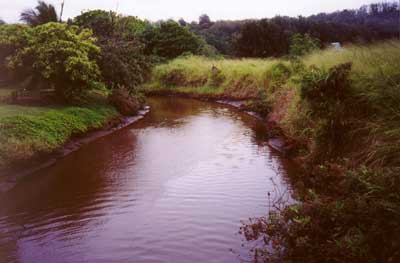 |
|
|
|
|
|
|
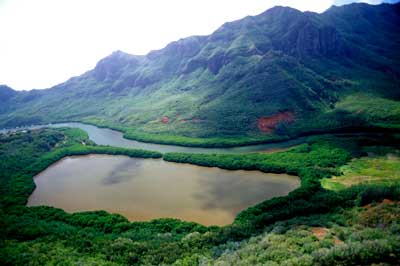 |
|
Hule'ia and Alekoko Fish Pond:
What's wrong with this picture?
Cheryl Lovell-Obatake says that construction of the breakwater
and small boat harbor have affected the circulation of water
through the pond. |
|
|
Photo by David Boynton, pilot - Casey Riemer of
Jack Harter Helicopters.
|
|
 |
|
Students at Kaua'i High School have adopted the ahupua'a of
Nawiliwili Bay. Since1999, they have been assessing and sampling
the Hule'ia, Nawiliwili, and Pu'ali streams. They are concerned
because Nawiliwili Bay is a vital part of Hawaiian cultural
practices, resident leisure and recreation, and food gathering. |
|
|
|
|
|
|
| Students test for turbidity
(suspended solids in the water), dissolved oxygen, phosphates,
nitrates, pH, temperature, salinity, and coliform bacteria.
In addition, they measure stream flow, assess the presence of
native and alien species, and land use around the streams. They
are currently designing a questionnaire to analyze area residents'
use, knowledge, beliefs, and opinions about the issues at Nawiliwili
Bay. |
|
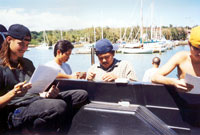 |
|
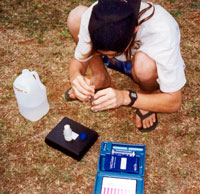 |
|
|
|
|
|
|
|
|
|
|
|
|
|
|
|
|
|
|
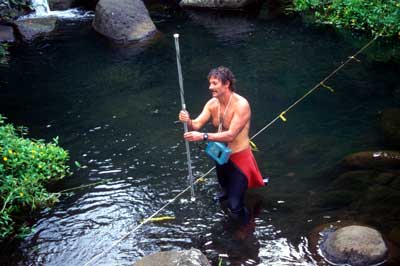 |
|
Aquatic specialists like Don Heacock, Adam Asquith, and Carl
Berg are willing mentors for these students. To the left, Don
Heacock - a continuous stream of knowledge. |
|
|
|
|
Photo by David Boynton
|
|
|
|
|
|
|
|
|
'Ainakumuwai is the land that is
the source of water. The designation of Nawiliwili Bay as a
Water Quality Limited Segment tells us that our land and water
use are not sustainable today. What will happen tomorrow? |
|
|
|
|
|
|
|
|
|
|
|






